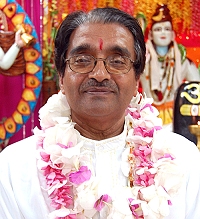From an interview with Paramacharya of SWAHA, Pt. Hardeo Persad
It is stated in our scriptures that there was once a war between the Devas (gods) and Asuras (demons). The war raged for quite some time and both sides looked to Bhagavan Vishnu for a solution. They were advised to churn the ocean of milk. The opposing sides called a truce in order to find a solution to the war. In life, similarly, we must sometimes work together with negative people in order to find a solution to a problem.
Both sides placed the mountain, Mandarachal, in the ocean of milk, as a pivot. They asked the serpent Vasuki to coil itself around the mountain. Then each side took hold of either the head or tail of the serpent and churned the ocean of milk. Without support, the mountain sank into the ocean, so Lord Vishnu manifested Himself as an enormous tortoise, Kurma Avatar. He dived underneath the mountain and served as a fulcrum, supporting the base of the mountain. Lord Vishnu advised the Devas to hold the head and the Asuras to use the tail and churn once more. The demons protested that they could not hold on to the snake’s tail as it was an inauspicious part of the animal. They demanded that they be allocated the head. Lord Vishnu permitted them to exchange places. However, the head of the snake emitted venom, damaging the asuras. The churning process occurred and 14 items emerged from the ocean, including poison and nectar, both of which are aspects of life. As the deadly poison emerged, it began to destroy on all sides.
Lord Vishnu advised them to go to Lord Shiva, the Destroyer and Reabsorber, to deal with the poison. So, they took the poison to Him, who consumed it in order to champion the cause of humankind. The poison did not affect Him as He kept it in his throat and did not allow it to reach His heart or stomach. Thus, His throat turned blue and he was called Neel Kanth, the Blue-Throated One. Fumes began to emanate from Him and they began to pour water to cool Him. It is said that this is the mythological origin of Shiv Raatri.
Hinduism is a very symbolic religion. As such, we must plumb the depths of the mythology in order to understand its meaning and application to us in our daily lives as well as in our spiritual quest. Lord Shiva symbolizes the state of dispassion, vairaagya. The poison that emerged represents the poisons of materialism. Our scriptures have referred to the world as a pitcher of materialism, the deadliest of all poisons. We drink of it and poison ourselves without even knowing it. It is the cause of suffering and anguish. In order to counteract the poison, we must develop a state of dispassion and then we will not be consumed by materialism. Detachment consumes the materialism and frees us from bondage to this world.
The lingam is an abstract or iconic form of Lord Shiva. Various forms of the lingam are depicted but the most common one is the shape of a vertical rounded column. The first lingam was a column of fire that appeared during the time of creation. One of the meanings of the name Shiva is auspiciousness, and lingam means symbol. It is, therefore, a symbol of Shiva, who is All Auspiciousness. It symbolizes the formlessness of the Supreme Shiva, the substratum, from whom everything emanates and into whom everything eventually merges. It also denotes the attributes of the Lord in His many manifestations: Shiva as the Creator, Sustainer and Destroyer or Reabsorber. The lingam is representative of the link between the manifest universe and the unmanifest, that is, the unseen cosmic realm. It symbolizes the eternal, imperceptible nature of time. The worship of Bhagavan Shiva via the lingam is most effective, especially during the auspicious occasion of Mahaa Shiva Raatri.



